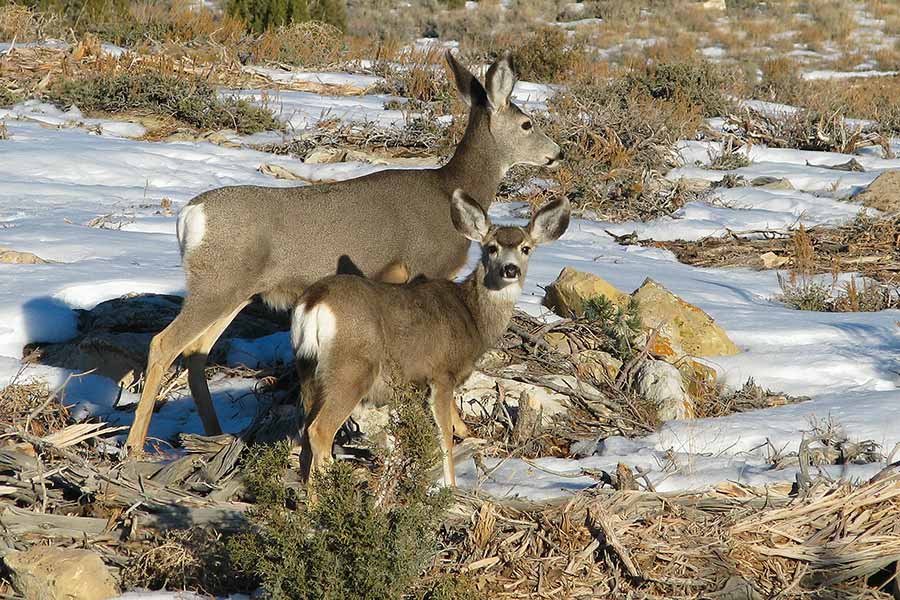6 local wildlife species that have a unique winter prep routine
Salt Lake City — As the weather gets colder and the snow starts to fly, many Utahns make necessary preparations such as buying snow shovels and digging winter coats and scarves out of storage. Some wildlife species also prep for the winter — here is a look at some of the unique ways that local animals survive Utah's snowy months.
Hoary bat
The hoary bat is the largest of the 18 species of bats that live in Utah. They have a distinctive frosty fur and roost in trees. They can be found in wooded areas across the state.
Unlike many bats that retreat into hibernation during the winter, most hoary bats migrate to escape the cold temperatures. Although they are generally solitary, hoary bats may travel together in groups during their migration. The bats typically migrate in September and October and then return in April and May. They migrate southward and toward coastal areas.
Snowshoe hare
The snowshoe hare is highly adapted to living in snowy environments. In Utah, it is found mainly in coniferous forests and aspen, alder and willow thickets in high-elevation mountain regions.
"As its name suggests, it has extremely large 'snowshoe-like' feet to help it escape predators in deep snow," Kimberly Hersey, Utah Division of Wildlife Resources mammal conservation coordinator, said. "Snowshoe hares also use a camouflage technique to hide from predators like foxes and bobcats during snowy months. During the summer, the snowshoe hare is a brown color, but during the winter, its fur turns white to allow it to blend in with the snowy terrain."
Pikas
American pikas are small grayish-brown mammals that look like a cross between a rabbit and a mouse. They live in high-elevation talus rocky areas, and are commonly seen in the Wasatch, Uinta, Tushar and La Sal Mountains.
Rather than hibernating, pikas remain active during the winter. They prepare for the snowy, cold months by stockpiling food during the summer. They gather green vegetation and create "haypiles" of grasses and flowers, which they then store away in rocky areas. A Colorado study estimates that pikas make nearly 13,000 gathering trips to construct their average size of haypile for the winter. They then eat the haypile during the winter and stay active underneath the snow.
Ground squirrels
Like with bears, ground squirrels commonly hibernate each winter. They are only active for a few months each year, and during that time, they must gain a lot of weight in order to survive the winter. The total hibernation period can last up to 10 months, but it varies by age and sex, with juvenile males typically only hibernating four to five months each year. Each animal hibernates alone.
Ground squirrels are true hibernators, meaning that they are almost impossible to wake up during hibernation. Their body temperature drops to just above freezing, and their heart rate drops to less than 10 beats per minute. Their body metabolizes the fat reserves that they built up while eating during their active season.
Mountainsnails
Mountainsnails are native snails found throughout Utah. When the temperature begins to cool (typically in October), mountainsnails burrow into the soil or leaf fragments or they crawl deep into rock piles to help protect themselves from the cold. They then create an epiphragm, a temporary mucus sealant on their shell opening, which prevents them from drying out.
"It is important for snails to maintain their moisture levels or they will die," DWR native aquatic biologist Kate Holcomb said.
Mountainsnails typically become active again once the weather begins to warm and the snow starts melting, typically in April.
"Searching for mountainsnails and other native terrestrial snails is like treasure hunting," Holcomb said. "Sometimes you can find piles of empty mountainsnail shells, but it's much harder to find them alive. If you do happen to find a mountainsnail with an epiphragm, return the snail to where you found it. Sometimes they will attach to rocks or logs during their hibernation, so if you find one that is stuck to a rock, please do not pull it off."
Deer
While they are some of the more commonly seen wildlife around Utah, deer actually have quite a unique winter preparation routine. Deer spend the spring, summer and fall eating and building up fat reserves that help provide energy to get them through the snowy winter months.
While they don't hibernate, deer often migrate to lower elevations with less snow to find feed, and they grow thick coats to stay warm. Deer also reduce their activity during the winter to help conserve energy, which is why it is crucial for people and their dogs to not chase or harass deer during the winter and early spring.





















